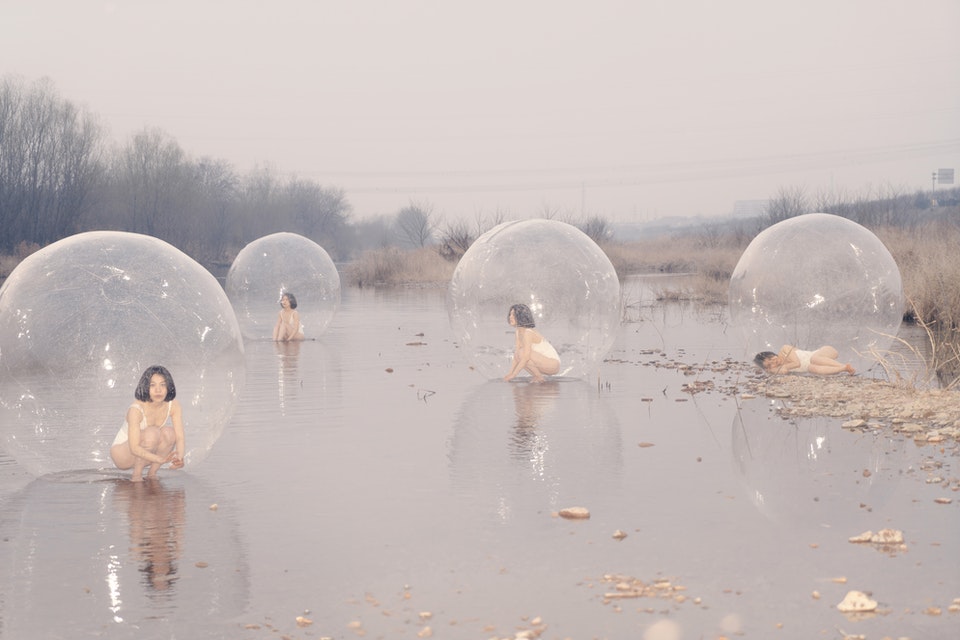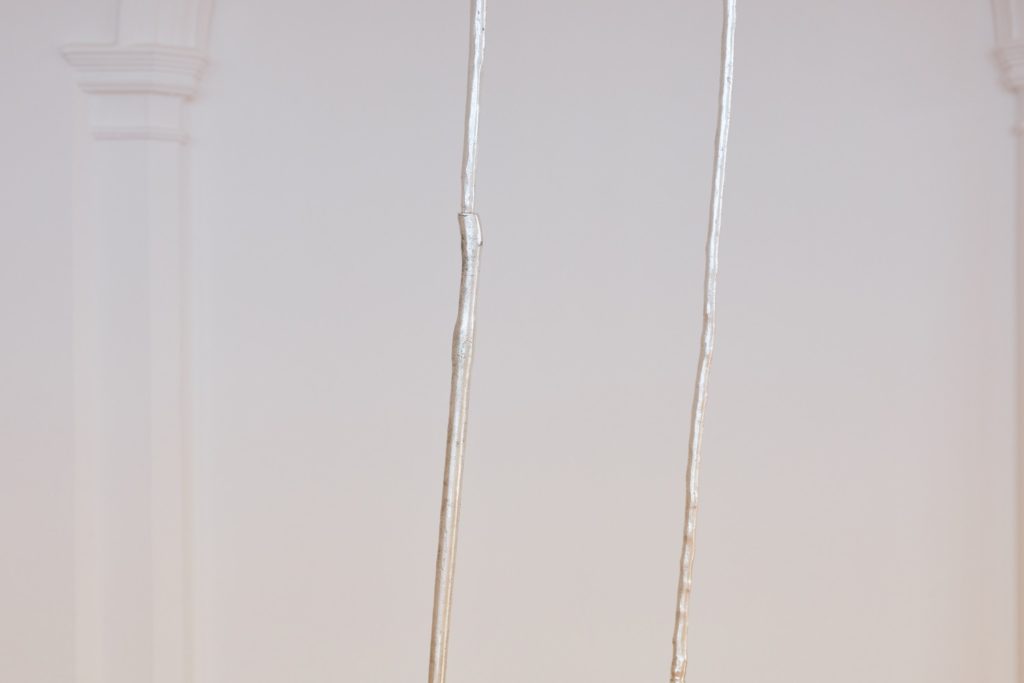Be Oblivion, in Disconnect
2011 - Installation (Installation)
Dimensions Variable
Natasha Wheat
Wheat’s work is built on a strong conceptual framework that weaves together commentary on social and political issues and the radical potential for change. Be Oblivion, in Disconnect (2011) is a sculpture and an intervention. Two cardboard boxes house white neon letters that collectively have the potential to spell “Be Oblivion.” The dismembered phrase is rendered powerless in its present state; the potential power lies with the viewer, who could conceivably reconstruct it. The boxes sit on wooden pallets of the kind typically used for shipping; by painting them white and repurposing them as pedestals, Wheat removes them from circulation as carriers of commodities. The simple cardboard boxes are also discarded shipping materials. The words “Be Oblivion” are a seeming command to fade away into obscurity. This simple phrase resonates as a harbinger of defeat. Perhaps the provocative installation is a pointed statement about our collective loss of power: in politics, commerce, war, international relations, social issues, or all of these. Wheat asks us to resurrect her jumbled phrase in our minds, contemplate it, and see if it is time for an insurrection.
Natasha Wheat’s diverse body of work explores social experience as a sensual phenomenon that is riddled with hierarchical complexity. Her objects, installations, and interventions engender and disrupt a full range of interpersonal relations. Wheat was the founder of Project Grow, an art studio and urban farming program based in Portland, Oregon, that employed developmentally disabled adults and investigated the intersection of food, ideology, society, and exchange. She earned her BFA from the School of the Art Institute of Chicago and an MFA with an emphasis in social practice from California College of the Arts.
Colors:
Related works sharing similar palette

© » ARTNEWS RETROSPECTIVE
Mary Weatherford Revisits an ARTnews Profile of Joan Mitchell – ARTnews.com Skip to main content By Alex Greenberger Plus Icon Alex Greenberger Senior Editor, ARTnews View All September 4, 2020 10:27am ©ARTnews In 1957, art critic Irving Sandler paid a visit to the studio of painter Joan Mitchell , an Abstract Expressionist known for her brushy images capturing nature...

© » KADIST
Milena Bonilla
2009Milena Bonilla’s discursive practice explores connections among economics, territory, and politics through everyday interventions...

© » KADIST
Voluspa Jarpa
2014In her work, Fantasmática Latinoamericana, Jarpa works from photographs of five public funeral processions following the mysterious deaths of five Latin American presidents...

© » KADIST
Gan Chin Lee
2019In Studies of Chinese New Villages II Gan Chin Lee’s realism appears in the format of a fieldwork notebook; capturing present-day surroundings while unpacking their historical memory...

© » KADIST
Mariana Castillo Deball
Mariana Castillo Deball’s set of kill hole plates are part of a larger body of work problematizing archeological narratives, and drawing attention to the conservation process and its role in recreating an imagined object...

© » KADIST
Marina Rosenfeld
2019The installation Music Stands: Free Exercise 7, 8, and 9 by Marina Rosenfeld consists of music stand-like structures and a corresponding set of panels and acoustic devices that direct, focus, obstruct, reflect and project sound in the gallery...

© » ARTFORUM
Title, Theme Announced for Sixth Aichi Triennale – Artforum Read Next: ART BASEL REVEALS EXHIBITOR LIST FOR 2024 SWISS FAIR Subscribe Search Icon Search Icon Search for: Search Icon Search for: Follow Us facebook twitter instagram youtube Alerts & Newsletters Email address to subscribe to newsletter...

© » KADIST
Colter Jacobsen
2010The title Untitled Passport II was first used by Felix Gonzalez-Torres in an unlimited edition of small booklets, each containing sequenced photographs of a soaring bird against an open sky...

© » KADIST
Nicolás Paris
2012Nicolas Paris studied architecture and worked as an elementary school teacher before he decided to become an artist...

© » SLASH PARIS
Guy Leclercq — Épures et couleurs — Galerie Dutko / Quai Voltaire — Exposition — Slash Paris Connexion Newsletter Twitter Facebook Guy Leclercq — Épures et couleurs — Galerie Dutko / Quai Voltaire — Exposition — Slash Paris Français English Accueil Événements Artistes Lieux Magazine Vidéos Retour Guy Leclercq — Épures et couleurs Exposition Peinture L’atelier de l’artiste Guy Leclercq Épures et couleurs Encore 27 jours : 7 décembre 2023 → 13 janvier 2024 La Galerie Dutko présente du 7 décembre 2023 au 13 janvier 2024 les œuvres récentes de l’artiste belge Guy Leclercq...

© » KADIST
Laura Gannon
2017The impressionistic surface of Wild Money (2017) recalls the 1950s paintings of Philip Guston...

© » 1854 PHOTOGRAPHY
Now on show in New York City: BJP's Female in Focus winners - 1854 Photography Subscribe latest Agenda Bookshelf Projects Industry Insights magazine Explore ANY ANSWERS FINE ART IN THE STUDIO PARENTHOOD ART & ACTIVISM FOR THE RECORD LANDSCAPE PICTURE THIS CREATIVE BRIEF GENDER & SEXUALITY MIXED MEDIA POWER & EMPOWERMENT DOCUMENTARY HOME & BELONGING ON LOCATION PORTRAITURE DECADE OF CHANGE HUMANITY & TECHNOLOGY OPINION THEN & NOW Explore Stories latest agenda bookshelf projects theme in focus industry insights magazine ANY ANSWERS FINE ART IN THE STUDIO PARENTHOOD ART & ACTIVISM FOR THE RECORD LANDSCAPE PICTURE THIS CREATIVE BRIEF GENDER & SEXUALITY MIXED MEDIA POWER & EMPOWERMENT DOCUMENTARY HOME & BELONGING ON LOCATION PORTRAITURE DECADE OF CHANGE HUMANITY & TECHNOLOGY OPINION THEN & NOW © Minxu Li, Female in Focus 2022 single image winner BJP’s new exhibition takes place in a converted Brooklyn townhouse, reflecting the award’s domestic focus The winners of BJP ’s Female in Focus 2022 include two series and 20 single images which demonstrate the sheer power of photography by women...

© » KADIST
Bruce Conner
1995Bruce Conner is best known for his experimental films, but throughout his career he also worked with pen, ink, and paper to create drawings ranging from psychedelic patterns to repetitious inkblot compositions...

© » WHITEHOT
Matthew Barney’s REPRESSIA (decline) at the Los Angeles County Museum of Art advertise donate post your art opening recent articles cities contact about article index podcast main December 2023 "The Best Art In The World" "The Best Art In The World" December 2023 Matthew Barney’s REPRESSIA (decline) at the Los Angeles County Museum of Art Matthew Barney, Cremaster 5 (production still), 1997 (fig...

© » KADIST
Gan Chin Lee
2019In Studies of Chinese New Villages II Gan Chin Lee’s realism appears in the format of a fieldwork notebook; capturing present-day surroundings while unpacking their historical memory...

© » KADIST
Gan Chin Lee
2019In Studies of Chinese New Villages II Gan Chin Lee’s realism appears in the format of a fieldwork notebook; capturing present-day surroundings while unpacking their historical memory...




